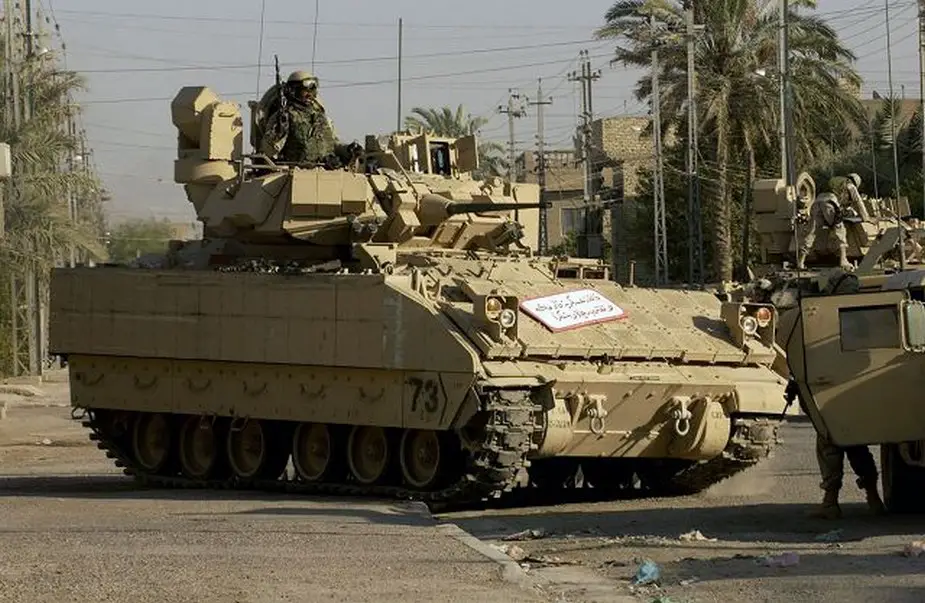The M2A5 Bradley concept has been canceled in favor of procuring an even more heavily-armed successor sooner, Sebastien Roblin reports on The National Interest. However, the Pentagon is moving ahead with plans for an M2A4 model equipped with an Active Protection System to intercept incoming missiles and rockets.

Having become too heavy for its power train and suspension, not enough protected against incoming missiles and rockets, its gun being considered not powerful enough, the M2A3 Bradley will have an adequate M2A4 successor (Picture source: US Army)
As reported in 2018 on army Recognition, the Pentagon was considering heavily upgrading its fleet of Bradley infantry fighting vehicles to an M2A5 model armed with a new 30-millimeter gun turret and capacity for a full nine-soldier squad. But an annual report makes clear that this M2A5 Bradley concept has been canceled in favor of procuring an even more heavily-armed successor, a more agile M2A4 model carrying an Active Protection System capable of intercepting incoming missiles and rockets.
As written by Sebastien Roblin, concerns over survivability led the Army to install additional conventional and explosive-reactive armor plates on its M2s, which saw extensive action in both Iraq wars, increasing weight from twenty-five to thirty-three tons. However, the vehicle’s suspension and powertrain were never modified for that additional weight, resulting in the Bradley becoming slower and lacking the electrical generation to incorporate additional upgrades. The weight also pushed the M2’s hull closer to the ground, worsening obstacle clearance and increasing vulnerability to mines and IEDs.
The U.S Army is proceeding with upgrades to the suspension and powertrain implemented through red tape-dodging “Engineering Change Proposals.” These will not only correct the Bradley’s increasing sluggishness but improve its electrical capacity so that it can utilize the “Iron Fist”—which would also add another 1,500 pounds to the Bradley’s weight.
In December 2018, the Army already announced it planned to rush-outfit an entire mechanized brigade with the Iron Fist. However, a separate testing report indicates that Iron Fist tests in 2018 revealed bugs and “demonstrated an inconsistent capability to intercept threats. Counter-munition dudding and power failures to the launcher were leading contributors to the low intercept rate.”
However, the Army plans to convert five M2A3-equipped brigades to M2A4 models, and forward deploy the assets for a sixth brigade of M2A4s to Europe. Ongoing live-fire tests of the new model’s survivability have so far yielded positive results, and will be complete by 2020.
Meanwhile, more modern IFV designs have incorporated larger auto-cannons, heavier armor, and even large 100-millimeter guns in some cases. Faced between upgrading the Bradley even further or opting for a new chassis, the Army would prefer the money to go to the latter. What is to be deplored is that, over the last two decades, the land-warfare service spent over $20 billion on two ambitious earlier program, the Future Combat System and the Ground Combat Vehicle, which both failed to yield results before being canceled, Sebatien Roblin reports.
The Pentagon is now hoping that the third attempt will be the good one, as it adopts a new philosophy for its Next Generation Combat Vehicle program: pursue proven, 80 percent solutions rather than accepting much higher costs and risks shooting for “exquisite” designs. Likewise, there is less emphasis on attempting to develop a one-size-fits-all solution for Army vehicles, which in an effort to lower costs has historically resulted in delays with program-fatal results.
Currently, the Army has three major candidates for the Bradley successor, called the Optionally-Manned Fighting Vehicle, which it would like to be capable of carrying both an Active Protection System and a powerful 50-millimeter cannon. These include the BAE’s CV90 Mark IV, Rheinmetall/Raytheon’s KF41 Lynx, and General Dynamics Griffon Mark III—all detailed in this article . As these all trace their lineage to existing, proven designs, and also have baked-in potential for adaptation to secondary roles, the Army hopes it will be able to finally find a Bradley replacement without having to reinvent the wheel.
The OMFV falls under the umbrella of the Next Generation Combat Vehicle projects, which also includes fielding of a lighter Armored Multi-Purpose Vehicle. Basically, the AMPV is a turretless Bradley dedicated to non-frontline combat missions which are nonetheless exposed to enemy ambushes—and serve as armored ambulances, forward command posts and mortar carriers. It should exhibit greater mobility and survivability compared to the aging M113s currently performing these roles, without requiring an expensive, high-risk development program.















